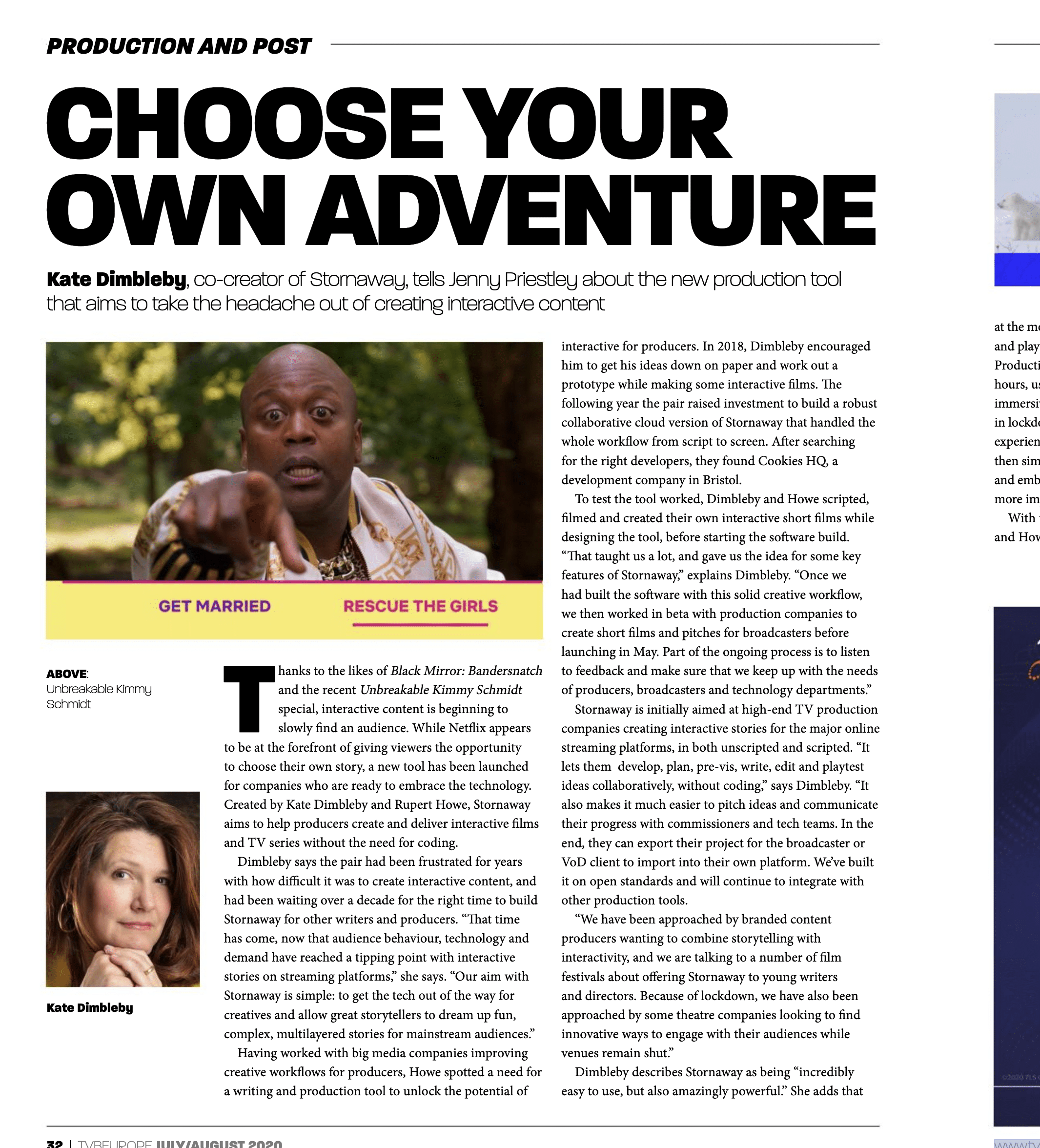Kate Dimbleby, co-creator of Stornaway, tells Jenny Priestley about the new production tool that aims to take the headache out of creating interactive content.
“At the moment, we tend to see branching narratives of the choose-your-path type. Stornaway starts to let us see how you can curate clips and sequences together in all kinds of ways, to craft journeys that let viewers see multiple perspectives, dive deeper, follow their interests. Creators will start to use tools like Stornaway to take back control, to keep audiences engaged with their own content in this non-linear world, rather than losing them to the algorithm.”
Thanks to the likes of Black Mirror: Bandersnatch and the recent Unbreakable Kimmy Schmidt special, interactive content is beginning to slowly find an audience. While Netflix appears to be at the forefront of giving viewers the opportunity to choose their own story, a new tool has been launched for companies who are ready to embrace the technology.
 Created by Kate Dimbleby and Rupert Howe, Stornaway aims to help producers create and deliver interactive films and TV series without the need for coding.
Created by Kate Dimbleby and Rupert Howe, Stornaway aims to help producers create and deliver interactive films and TV series without the need for coding.
Dimbleby says the pair had been frustrated for years with how difficult it was to create interactive content, and had been waiting over a decade for the right time to build Stornaway for other writers and producers. “That time has come, now that audience behaviour, technology and demand have reached a tipping point with interactive stories on streaming platforms,” she says.
“Our aim with Stornaway is simple: to get the tech out of the way for creatives and allow great storytellers to dream up fun, complex, multilayered stories for mainstream audiences.”
Having worked with big media companies improving creative workflows for producers, Howe spotted a need for a writing and production tool to unlock the potential of interactive for producers. In 2018, Dimbleby encouraged him to get his ideas down on paper and work out a prototype while making some interactive films. The following year the pair raised investment to build a robust collaborative cloud version of Stornaway that handled the whole workflow from script to screen. After searching for the right developers, they found Cookies HQ, a development company in Bristol.
To test the tool worked, Dimbleby and Howe scripted, filmed and created their own interactive short films while designing the tool, before starting the software build. “That taught us a lot, and gave us the idea for some key features of Stornaway,” explains Dimbleby.
“Once we had built the software with this solid creative workflow, we then worked in beta with production companies to create short films and pitches for broadcasters before launching in May. Part of the ongoing process is to listen to feedback and make sure that we keep up with the needs of producers, broadcasters and technology departments.”
Stornaway is initially aimed at high-end TV production companies creating interactive stories for the major online streaming platforms, in both unscripted and scripted.
“It lets them develop, plan, pre-vis, write, edit and playtest ideas collaboratively, without coding,” says Dimbleby. “It also makes it much easier to pitch ideas and communicate their progress with commissioners and tech teams.
In the end, they can export their project for the broadcaster or VoD client to import into their own platform. We’ve built it on open standards and will continue to integrate with other production tools.
“We have been approached by branded content producers wanting to combine storytelling with interactivity, and we are talking to a number of film festivals about offering Stornaway to young writers and directors. Because of lockdown, we have also been approached by some theatre companies looking to find innovative ways to engage with their audiences while venues remain shut.”
Dimbleby describes Stornaway as being “incredibly easy to use, but also amazingly powerful.” She adds that at the most basic level, users can visually map out a story and play-test it in just a few minutes. “Pins and Needles Productions used it to create an interactive film in 72 hours,using Arts Council Covid-19 funding to adapt an immersive theatre show – with 27 scenes and nine actors in lockdown,” she explains.  “In the final 24 hours, an experienced video editor cut the scenes and graphics, and then simply uploaded these into their Stornaway story map and embedded the Stornaway player on their website. Even more impressively, it was their first screen production.”
“In the final 24 hours, an experienced video editor cut the scenes and graphics, and then simply uploaded these into their Stornaway story map and embedded the Stornaway player on their website. Even more impressively, it was their first screen production.”
With the first release now out to the market, Dimbleby and Howe are working on adding more features, including integration with other tools, immersive authoring, and more scriptwriting and visual interactive options. “We have a product roadmap of about 150 features, and we’re prioritising them based on feedback from producers and writers,” she says.
As interactive storytelling is currently in its infancy, how does Dimbleby see it developing in the future? “First, we need creative tools like Stornaway to get technology out of the way of the storytellers,” she says. “The interactive Unbreakable Kimmy Schmidt special on Netflix was a fantastic example of really great writers and actors playing with the form; you could tell they were having fun, that they were acknowledging us as an audience, and making the most of the interactivity without it being a gimmick or detracting from story.
Thanks for reading. If you’re a creator or independent TV company looking to get started in interactive storytelling. Sign up for the free trial or get in touch with Kate for more details

